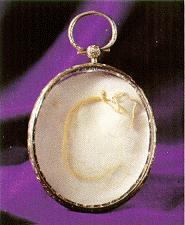 It is often people's hopes and fears, their enthusiasms and
frustrations, which drive them to do things a little differently.
Behind the normal everyday veneer of routine life, there is often a more
interesting story to be found. The museum collections include some wonderful
examples of the eccentric or the secret life of West Suffolk. Witchcraft has a long
tradition in rural communities such as ours, and at Moyse's Hall Museum are a
witches' puppet, witches' wands and witch bottles. The latter are Bellarmines
filled with sharp objects, urine and perhaps human hair. They were buried within
a house as protection, for it was supposed that any witch venturing near would be
trapped in the bottle. Old houses undergoing restoration often are found to
contain mummified cats and several from Fakenham Magna and Debenham are
on display - again part of a tradition of placing good luck charms within the
fabric of houses.
It is often people's hopes and fears, their enthusiasms and
frustrations, which drive them to do things a little differently.
Behind the normal everyday veneer of routine life, there is often a more
interesting story to be found. The museum collections include some wonderful
examples of the eccentric or the secret life of West Suffolk. Witchcraft has a long
tradition in rural communities such as ours, and at Moyse's Hall Museum are a
witches' puppet, witches' wands and witch bottles. The latter are Bellarmines
filled with sharp objects, urine and perhaps human hair. They were buried within
a house as protection, for it was supposed that any witch venturing near would be
trapped in the bottle. Old houses undergoing restoration often are found to
contain mummified cats and several from Fakenham Magna and Debenham are
on display - again part of a tradition of placing good luck charms within the
fabric of houses.
And what other enthusiasms and great ideas have stood the test of time insofar as
Moyse's Hall has found a home for them? The gigantic slab of coal (reputedly the
largest individual lump then mined) used as a trader's sign? Or perhaps the turtle
shell that served as a shop sign in the town centre at Cupola House? Or perhaps
pride of place should go to the model of a medieval church made entirely of snail
shells? Everybody has their favourite exhibit at Moyse's Hall Museum, and
whichever is yours, there is a good Suffolk expression for it: "Thass a rummun!"



 It is often people's hopes and fears, their enthusiasms and
frustrations, which drive them to do things a little differently.
Behind the normal everyday veneer of routine life, there is often a more
interesting story to be found. The museum collections include some wonderful
examples of the eccentric or the secret life of West Suffolk.
It is often people's hopes and fears, their enthusiasms and
frustrations, which drive them to do things a little differently.
Behind the normal everyday veneer of routine life, there is often a more
interesting story to be found. The museum collections include some wonderful
examples of the eccentric or the secret life of West Suffolk.